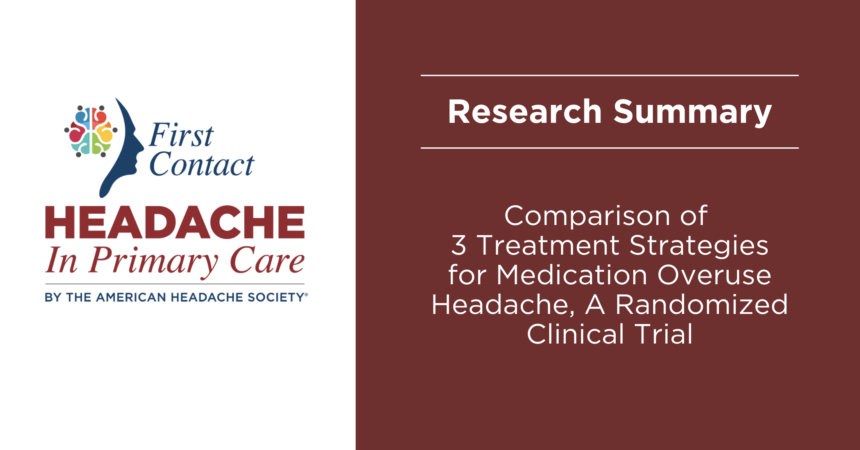
Research Summary: Treatment Strategies for Medication Overuse Headache
Medication overuse headache (MOH) is characterized by escalating headache frequency and the progressive use of short-term medication. This can result in episodic headache syndromes such as migraine transforming to chronic, refractory headaches. Comparison of 3 Treatment Strategies for Medication Overuse Headache, A Randomized Clinical Trial, a study on MOH, was recently published in JAMA Neurology. For the study, researchers set out to determine the best treatment strategy for this type of headache. They studied the following treatment arms:
-
- Withdrawal of short-term medication with initiation of preventive treatment
- Adding preventive treatment without withdrawal of short-term medication
- Withdrawal of short-term medication with postponed optional prevention therapy added later
The primary outcome was a change in headache days per month from baseline to 6 months.
Study Methods
- Patients were scheduled for a visit at baseline, and then again at 2 and 6 months in person, with telephone calls at 1 and 4 months after initiation of treatment
- Headache calendar was used to track headache and migraine days, pain intensity and days where patients used short-term medications
- Withdrawal protocol was given by nurses trained in headache medicine, and then patients were told to discontinue short-term medication for 2 months, after which they could use medication but no more than 9 days a month (or 14 days a month if simple analgesic)
- The preventive-only group was not given restrictions on medication usage
- Preventive therapies were chosen according to existing guidelines
Study Results
- 120 patients were included in the study
- Reduction in headache days per month:
- Withdrawal plus preventive group – 12.3 less days
- Preventive-only group – 9.9 less days
- Withdrawal only group – 8.5 less days
- In terms of secondary outcomes, the patients in the withdrawal plus preventive group experienced less migraine days, less days per month of medication use and lower pain intensity compared to the other groups
- Percent resolved of MOH at 6 months:
- Withdrawal plus preventive group – 96.8%
- Preventive-only group – 74.3%
- Withdrawal only group – 88.9%
Conclusion
- All treatment strategies studied were effective in reducing monthly headache days
- The largest reduction in headache days, migraine days, days with medication use and pain intensity was experienced by the patients in the withdrawal plus preventive group
- The recommendation by the authors is to initiate preventive therapy at the time of withdrawal of acute medications given it was the most effective based on both the primary and secondary outcomes
Implications for Primary Care Clinicians
- It is never too early to address medication overuse headache with patients
- Patients can be reassured that if they have medication overuse headache, their prognosis is good regardless of strategy used
- The most effective strategy in this study is starting a preventive therapy and simultaneously a withdrawal taper of an overused medication which can be employed in a primary care setting
This summary is part of the First Contact — Headache in Primary Care initiative, an American Headache Society program that provides educational resources to empower healthcare professionals and improve headache and migraine care. We encourage providers in all stages of their careers to visit our homepage to access educational tools to improve patient care.


